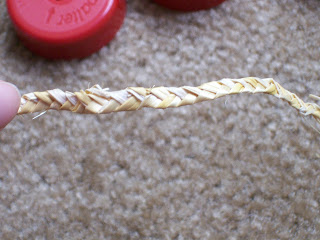The Challenge: Make a dish meant for a picnic.
The Recipe: Fruit Turnovers (suitable for Pic-Nics), from Mrs. Beeton's Book of Household Management
1278. INGREDIENTS – Puff-paste No. 1206, any kind of fruit, sugar to taste.
Mode.—Make some puff-paste by recipe No. 1206; roll it out to the thickness of about 1/4 inch, and cut it out in pieces of a circular form; pile the fruit on half of the paste, sprinkle over some sugar, wet the edges and turn the paste over. Press the edges together, ornament them, and brush the turnovers over with the white of an egg; sprinkle over sifted sugar, and bake on tins, in a brisk oven, for about 20 minutes. Instead of putting the fruit in raw, it may be boiled down with a little sugar first, and then inclosed in the crust; or jam, of any kind, may be substituted for fresh fruit.
Time.—20 minutes.
Sufficient—1/2 lb. of puff-paste will make a dozen turnovers.
MEDIUM PUFF-PASTE
1206. INGREDIENTS – To every lb. of flour allow 8 oz. of butter, 4 oz. of lard, not quite 1/2 pint of water.
Mode.—This paste may be made by the directions in the preceding recipe, only using less butter and substituting lard for a portion of it. Mix the flour to a smooth paste with not quite 1/2 pint of water; then roll it out 3 times, the first time covering the paste with butter, the second with lard, and the third with butter. Keep the rolling-pin and paste slightly dredged with flour, to prevent them from sticking, and it will be ready for use.
The Date/Year and Region: 1861, British
How Did You Make It: Made a paste of 1 lb (3 1/3 cups) flour and a scant cup of water, as directed. Rolled out paste with 4 oz of butter, 4 oz of lard, and another 4 oz of butter. Rolled out a fourth time, cutting the paste into circles with a knife and wide-mouth glass; folded each paste circle over a spoonful of jam, then topped with egg white and sugar as directed. I took "decorate" to mean "prick the crust such that it looks pretty and doesn't explode." Baked at 350F for approximately 20 min. I also made two turnovers using fresh strawberries with a pinch of sugar rather than the raspberry jam--about half of a very large strawberry (cut fine) was sufficient for each.
Time to Complete: About 1 hour.
Total Cost: Ingredients on hand. Takes 1 lb flour, 1/2 lb butter, 4 oz. lard, and an 18-oz jar of jam, as made up here.
How Successful Was It?: Tasty. The pastry is palatable, thought perhaps less rich than the all-butter puff paste I've used before (in chicken puffs, vegetable pie, jam tart, and cherry pie). The jam is, well, jam. Would make again, especially for period pic-nic-ing.
How Accurate Is It?: Cooked in an electric oven, but otherwise didn't tamper with the receipt. I ended up with 3 dozen turnovers rather than 2, so I suspect they're meant to be made a bit larger.








